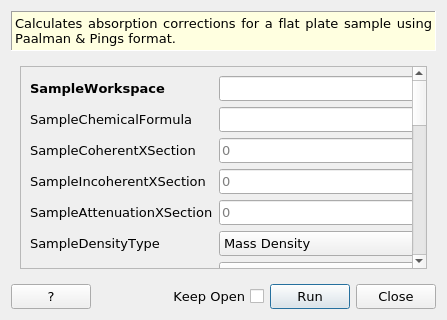\(\renewcommand\AA{\unicode{x212B}}\)
FlatPlatePaalmanPingsCorrection v1¶

FlatPlatePaalmanPingsCorrection dialog.¶
Summary¶
Calculates absorption corrections for a flat plate sample using Paalman & Pings format.
Properties¶
Name |
Direction |
Type |
Default |
Description |
|---|---|---|---|---|
SampleWorkspace |
Input |
Mandatory |
Name for the input sample workspace |
|
SampleChemicalFormula |
Input |
string |
Sample chemical formula |
|
SampleCoherentXSection |
Input |
number |
0 |
The coherent cross-section for the sample material in barns. To be used instead of Chemical Formula. |
SampleIncoherentXSection |
Input |
number |
0 |
The incoherent cross-section for the sample material in barns. To be used instead of Chemical Formula. |
SampleAttenuationXSection |
Input |
number |
0 |
The absorption cross-section for the sample material in barns. To be used instead of Chemical Formula. |
SampleDensityType |
Input |
string |
Mass Density |
Use of Mass density or Number density for the sample. Allowed values: [‘Mass Density’, ‘Number Density’] |
SampleNumberDensityUnit |
Input |
string |
Atoms |
Choose which units SampleDensity refers to. Allowed values: [Atoms, Formula Units]. Allowed values: [‘Atoms’, ‘Formula Units’] |
SampleDensity |
Input |
number |
0.1 |
The value for the sample Mass density (g/cm^3) or Number density (1/Angstrom^3). |
SampleThickness |
Input |
number |
0 |
Sample thickness in cm |
SampleAngle |
Input |
number |
0 |
Angle between incident beam and normal to flat plate surface |
CanWorkspace |
Input |
Name for the input container workspace |
||
CanChemicalFormula |
Input |
string |
Container chemical formula |
|
CanCoherentXSection |
Input |
number |
0 |
The coherent cross-section for the can material in barns. To be used instead of Chemical Formula. |
CanIncoherentXSection |
Input |
number |
0 |
The incoherent cross-section for the can material in barns. To be used instead of Chemical Formula. |
CanAttenuationXSection |
Input |
number |
0 |
The absorption cross-section for the can material in barns. To be used instead of Chemical Formula. |
CanDensityType |
Input |
string |
Mass Density |
Use of Mass density or Number density for the can. Allowed values: [‘Mass Density’, ‘Number Density’] |
CanNumberDensityUnit |
Input |
string |
Atoms |
Choose which units CanDensity refers to. Allowed values: [Atoms, Formula Units]. Allowed values: [‘Atoms’, ‘Formula Units’] |
CanDensity |
Input |
number |
0.1 |
The value for the can Mass density (g/cm^3) or Number density (1/Angstrom^3). |
CanFrontThickness |
Input |
number |
0 |
Container front thickness in cm |
CanBackThickness |
Input |
number |
0 |
Container back thickness in cm |
NumberWavelengths |
Input |
number |
10 |
Number of wavelengths for calculation |
Interpolate |
Input |
boolean |
True |
Interpolate the correction workspaces to match the sample workspace |
Emode |
Input |
string |
Elastic |
Energy transfer mode. Allowed values: [‘Elastic’, ‘Indirect’, ‘Direct’, ‘Efixed’] |
Efixed |
Input |
number |
0 |
Analyser energy (mev). By default will be read from the instrument parameters. Specify manually to override. This is used only in Efixed energy transfer mode. |
OutputWorkspace |
Output |
WorkspaceGroup |
Mandatory |
The output corrections workspace group |
Description¶
Calculates absorption corrections for an infinite flat plate sample giving output in the Paalman and Pings absorption factors: \(A_{s,s}\) (scattering and absorption in sample), \(A_{s,sc}\) (scattering in sample and absorption in sample and container), \(A_{c,sc}\) (scattering in container and absorption in sample and container) and \(A_{c,c}\) (scattering and absorption in container).
Details of the analytical method used to calculate the correction factors is available in RAL Technical Report 74-103.
Restrictions on the input workspace¶
The input workspaces must have a fully defined instrument.
In the energy transfer modes other than Efixed they have to have X axis units of wavelength.
Efixed mode¶
In Efixed mode, the correction will be computed for a single wavelength number derived from the analyser or monochromator energy, which by default will be attempted to be read from the instrument parameters (named Efixed), but can also be overridden in the Efixed input property. In this case, the NumberWavelengths and Interpolate options will be ignored.
Workflow¶
Usage¶
Example:
# Create a sample workspace
sample = CreateSampleWorkspace(NumBanks=1, BankPixelWidth=1,
XUnit='Wavelength',
XMin=6.8, XMax=7.9,
BinWidth=0.1)
# Copy and scale it to make a can workspace
can = CloneWorkspace(InputWorkspace=sample)
can = Scale(InputWorkspace=can, Factor=1.2)
# Calculate absorption corrections
corr = FlatPlatePaalmanPingsCorrection(SampleWorkspace=sample,
SampleChemicalFormula='H2-O',
SampleThickness=0.1,
SampleAngle=45,
CanWorkspace=can,
CanChemicalFormula='V',
CanFrontThickness=0.01,
CanBackThickness=0.01,
Emode='Indirect',
Efixed=1.845)
print('Correction workspaces: %s' % (', '.join(corr.getNames())))
Output:
Correction workspaces: corr_ass, corr_assc, corr_acsc, corr_acc
